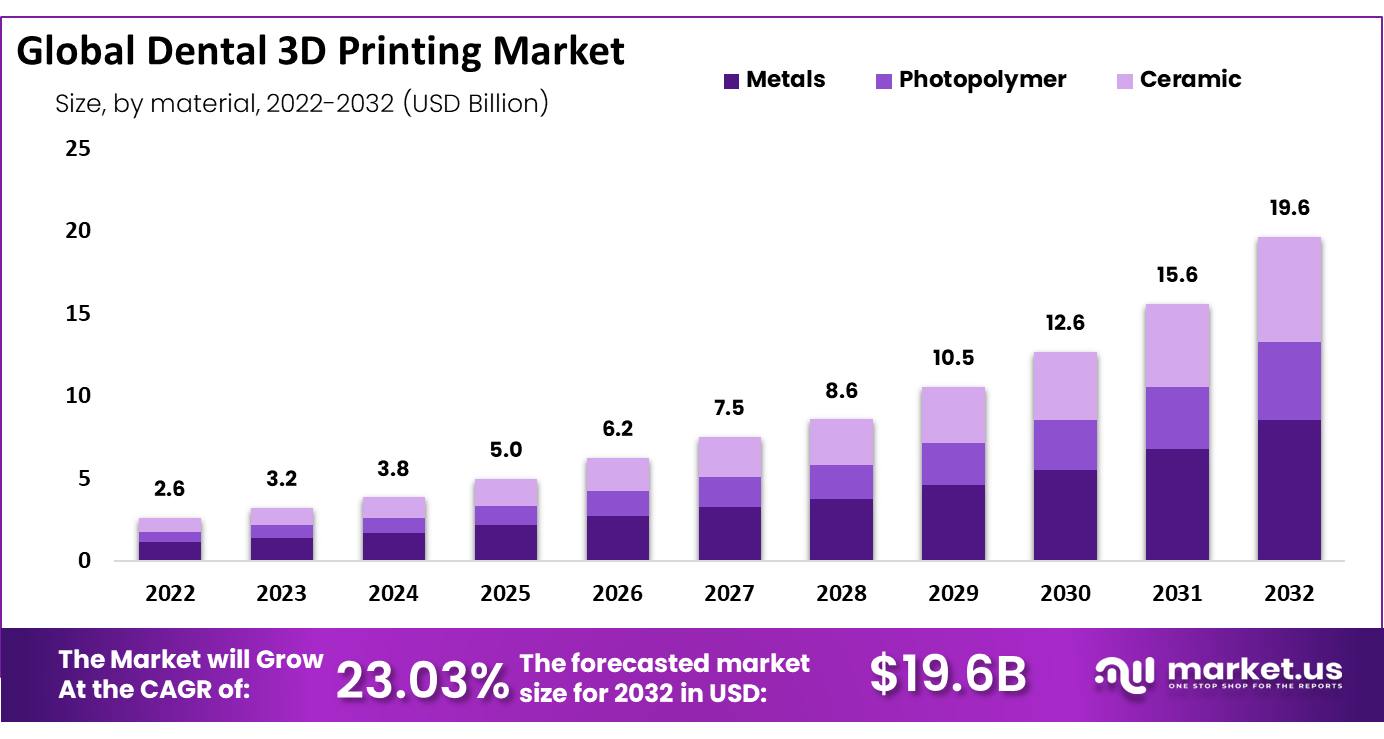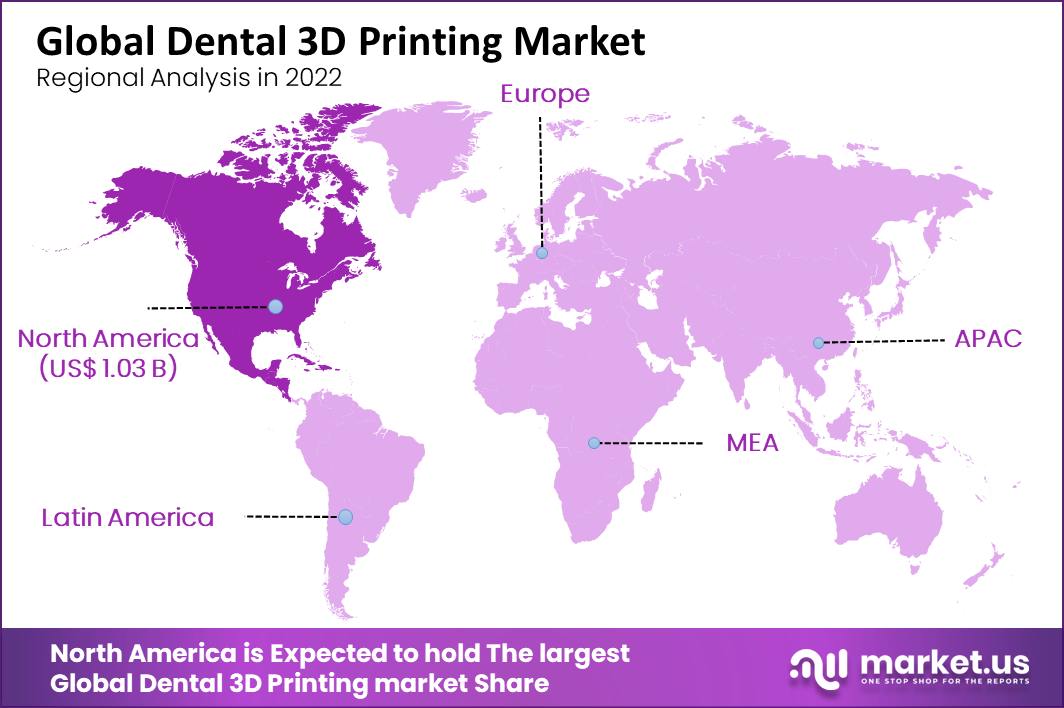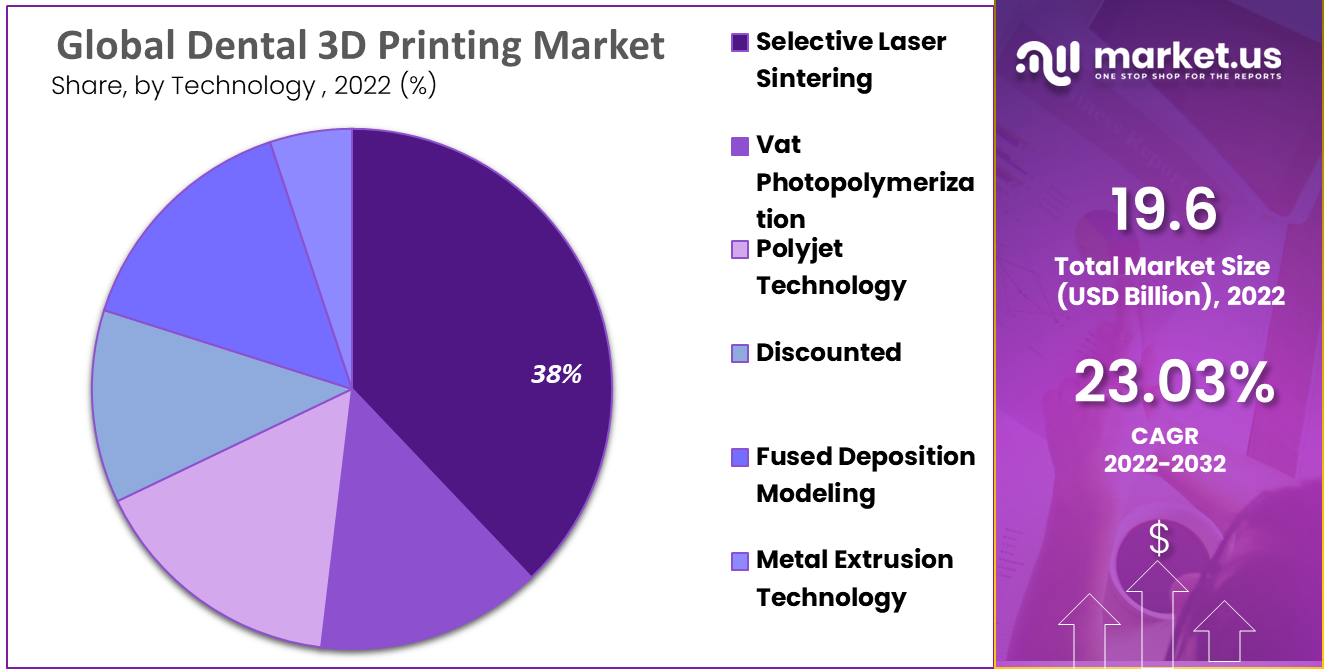New York, Dec. 11, 2023 (GLOBE NEWSWIRE) -- According to Market.us, the global dental 3D printing market size reached a valuation of USD 3.2 Billion in 2023. Anticipated to experience substantial growth, the market is estimated to achieve the highest Compound Annual Growth Rate (CAGR) of 23.03% between 2023 and 2032. Projections suggest that by 2032, the market is expected to soar to USD 19.6 Billion.
In the realm of modern dental solutions, the integration of cutting-edge 3D printing technology has firmly established dental 3D printers as indispensable tools. Their prevalence is notably attributed to advancements like invisible aligners and enhanced manufacturing capabilities, fostering a surge in acceptance and demand. The synergy of innovation and a strategic footprint has propelled these printers into a pivotal position within the dental industry. This transformative technology not only expedites fabrication processes, elevating production output, but also digitalizes workflows, minimizing procedural complexities and enhancing overall client satisfaction.
Sample Report Request: Unlock Valuable Insights for Your Business: https://market.us/report/dental-3d-printing-market/request-sample/
The advent of user-friendly 3D printing techniques has inspired the dental sector to create products tailored to diverse needs. The inherent ease of these printers streamlines processes, significantly accelerating production while ensuring a high-quality end result. By embracing this technology, the dental industry aims to address the oral health requirements of a broad spectrum of individuals, marking a shift toward digitalized workflows that alleviate procedural inconveniences and contribute to heightened client contentment.
Key Takeaway
- Market Growth: The global dental 3D printing market soared from USD 3.2 billion in 2023 to an anticipated USD 19.6 billion by 2032, boasting a remarkable 23.03% CAGR.
- Material Dominance: Metals, notably cobalt-chrome and titanium, command a robust 43.5% revenue share in the dental 3D printing market in 2022.
- Technology Dominance: Selective laser sintering leads with a substantial 37.9% market share in 2022, fueled by research investments and material advancements.
- Application Dominance: The orthodontics category holds a significant 39.0% market share in 2022, driven by 3 million American and Canadian teenagers wearing braces.
- End-User Dominance: Dental laboratories dominate with a 55.5% revenue share in 2022, propelled by technology adoption and increased outsourcing.
- Regional Focus: North America, particularly the United States, is the epicenter of the market, contributing significantly with 38.9% of the total revenue in 2022.
Factors affecting the growth of the Dental 3D Printing industry
- Technology Advancements: New and improved technologies make it easier to create precise and customized dental implants and prosthetics using 3D printing, driving the industry forward.
- Material Innovation: The development of better printing materials, like biocompatible resins and metals, enhances the quality and durability of dental 3D printed products, influencing industry growth.
- Cost Reduction: As the cost of 3D printing equipment and materials decreases, more dental professionals can afford to integrate this technology into their practices, fostering industry expansion.
- Rising Demand for Customization: Patients increasingly seek personalized dental solutions. 3D printing allows for tailor-made products, meeting the growing demand for individualized and aesthetically pleasing dental treatments.
Get deeper insights into the market size, current market scenario, future growth opportunities, major growth driving factors, the latest trends, and much more. Buy the full report here
Regional Analysis
North America stands as the undisputed leader in the Dental 3D Printing Market, commanding an impressive market share exceeding 38.9% of total revenue. This ascendancy is underpinned by a robust healthcare infrastructure and a penchant for technological innovation. The region's advanced healthcare facilities provide an ideal environment for integrating cutting-edge technologies, fostering widespread acceptance of 3D printing in dental applications. Notably, North America's proactive approach towards adopting advanced dental technologies, coupled with a culture of continuous innovation, positions it as a global trendsetter in the dental industry.
Despite this dominance, challenges such as high initial costs and the need for continuous professional training persist. However, these challenges present strategic opportunities for market players to invest in cost-effective solutions and educational initiatives. Looking ahead, North America's Dental 3D Printing Market is poised for further growth, fueled by ongoing technological advancements, increased awareness among dental professionals, and a rising demand for personalized dental solutions. Market participants should navigate this dynamic landscape with targeted collaborations, research, and development efforts to capitalize on the region's thriving dental ecosystem.
To understand how our report can make a difference to your business strategy, Inquire about a brochure at https://market.us/report/dental-3d-printing-market/#inquiry

Scope of the Report
| Report Attributes | Details |
| Market Value (2023) | US$ 3.2Billion |
| Forecast Revenue 2033 | US$ 19.6 Billion |
| CAGR (2024 to 2033) | 23.03% |
| North America Revenue Share | 38.9% |
| Base Year | 2022 |
| Historic Period | 2018 to 2022 |
| Forecast Year | 2024 to 2033 |
Market Drivers
The surge in digital dentistry is driving the dental 3D printing market, with dentists and labs embracing digital technologies like scanning and CAD/CAM software for designing dental restorations. Notably, the evolution of 3D printing, employing technologies like multi-jet printing and laser sintering, has enhanced the production of precise dental solutions, reducing time and costs. Patients now demand personalized dental treatments, such as custom implants and aligners, facilitated by the efficiency and accuracy of 3D printing. Compounding this trend is the global uptick in dental disorders like decay and periodontal disease, escalating the need for advanced dental treatments and restorations.
Market Restraints
Dental 3D printing demands substantial upfront capital, encompassing technology, equipment, and software, posing a formidable entry barrier for smaller dental practices and labs. This high initial investment creates a financial hurdle, limiting accessibility to the technology. Moreover, despite rapid advancements in 3D printing, a notable impediment persists the scarcity of skilled professionals proficient in operating and maintaining such sophisticated systems. This shortage of expertise hampers the broader market expansion, as the full potential of dental 3D printing remains constrained by the industry's struggle to cultivate a workforce equipped with the necessary skills to harness this transformative technology effectively.
Market Opportunities
The utilization of 3D printing technology in dentistry allows for the creation of personalized dental solutions tailored to individual patient needs. This not only enhances patient outcomes but also contributes to heightened satisfaction. Beyond customization, the technology proves instrumental in boosting efficiency and productivity within dental labs and practices. It achieves this by minimizing production time and waste, and facilitating swift turnaround times for dental restorations. Additionally, the increasing use of 3D printing could significantly improve access to dental care, especially in remote or underserved areas where conventional dental services are limited. As 3D printing becomes more common, it brings about new and creative business approaches and income opportunities for dental practices. This includes services such as on-demand printing and creating custom dental solutions for other practices.
Immediate Delivery Available | Buy This Premium Research Report https://market.us/purchase-report/?report_id=12413
Report Segmentation of the Dental 3D Printing Market
Material Insight
In terms of materials, the global dental 3D printing market is categorized into metals, photopolymers, and ceramics. Notably, the metals segment stands out as the most profitable, contributing significantly with a 43.5% share of total revenue in 2022. This prominence is attributed to the widespread utilization of metals like cobalt-chrome and titanium, particularly in crafting dental implants, leveraging their robustness, biocompatibility, and longevity. The process of metal 3D printing commonly employs selective laser melting (SLM) or electron beam melting (EBM) techniques. Meanwhile, ceramics, such as zirconia and alumina, find favor in producing dental crowns and bridges due to their aesthetic appeal and biocompatibility, employing lithography-based ceramic manufacturing (LCM). Additionally, polymers like acrylic and polyurethane play a crucial role in fabricating dental models and orthodontic aligners through the stereolithography (SLA) process.
Technology Insight
In the rapidly evolving landscape of 3D printing technologies, various segments vie for prominence. The market is delineated by key technologies, including Vat Photopolymerization, Polyjet Technology, Discounted, Fused Deposition Modeling, Selective Laser Sintering, and Metal Extrusion Technology. Notably, Selective Laser Sintering emerges as the frontrunner, commanding a substantial 37.9% revenue share in 2022 and poised to sustain its dominance throughout the forecast period. While other segments exhibit growth potential, the unparalleled position of Selective Laser Sintering is attributed to intensified research and development investments in cutting-edge procedures like material jetting, electron beam melting, and binder jetting. Fused Deposition Modeling gains traction, particularly in dentistry, fueled by its cost-effectiveness and the prevalence of robust, biocompatible thermoplastics, addressing the rising challenges of edentulism and tooth decay.

End-User Insight
In 2022, the dental laboratories market claimed the largest share of revenue at 55.5%. This dominance is expected to persist over the forecast period, showcasing the segment's robust Compound Annual Growth Rate (CAGR). The surge in this sector is attributed to the increasing integration of advanced technology by dental laboratories. Notably, the adoption of cutting-edge technologies and the burgeoning demand for dental 3D printing are propelling the market forward. This momentum is further amplified by the growing trend of outsourcing manufacturing tasks to dental laboratories and the heightened need for customized dental framing solutions across various applications. These factors collectively contribute to the sustained expansion and promising future of the dental laboratories market.
Request our sample report for critical market insights and emerging trends: https://market.us/report/dental-3d-printing-market/request-sample/
Market Segmentation
Based on Material
- Metals
- Photopolymer
- Ceramic
Based on Technology
- Vat Photopolymerization
- Polyjet Technology
- Discounted
- Fused Deposition Modeling
- Selective Laser Sintering
- Metal Extrusion Technology
Based on Application
- Prosthodontics
- Orthodontics
- Implantology
Based on End-User
- Dental Laboratories
- Dental Clinics
- Hospitals & Clinics
- Academic and Research Institute
- Other End Users
By Geography
- North America
- US
- Canada
- Europe
- Germany
- France
- The UK
- Spain
- Italy
- Russia
- Netherland
- Rest of Europe
- Asia Pacific
- China
- Japan
- South Korea
- India
- New Zealand
- Singapore
- Thailand
- Vietnam
- Rest of APAC
- Latin America
- Brazil
- Mexico
- Rest of Latin America
- Middle East & Africa
- South Africa
- Saudi Arabia
- UAE
- Rest of MEA
Competitive Landscape
Several key players in the dental 3D printing market are strategically positioning themselves for international expansion. Through a combination of measures, such as enhancing existing operations and investing in research and development facilities, these companies aim to bolster their market presence. Emphasizing product innovation, strategic partnerships, and collaborations, these players actively seek to enlarge their market share and maintain a competitive edge. At present, Stratasys and 3D Systems dominate the dental 3D printing landscape, with Stratasys offering a diverse range of dental 3D printers like Object Eden260V and Objet30 OrthoDesk, and 3D Systems showcasing the Next Dent 5100 3D printer tailored for dental applications.
Market Key Players
- 3D Systems
- Stratasys Ltd
- Renishaw
- Roland DG
- SLM Solutions
- EnvisionTEC
- Dentsply Sirona
- Straumann
- Form Labs
- Prodways Group
- Planmeca
- Asiga Carbon Inc
- DSI Ltd
- Trumph
- Keystone Industries
- Zortax S A
- Sprint Ray Inc
- General Electric Company
- Rapid Shape Gmbh
- Other Key Players
Recent Developments in the Dental 3D Printing Market
- February 2023: Renishaw, Announced the launch of a new dental 3D printing material, Renishaw AM230. This cobalt-chromium alloy material is specifically designed for printing partial denture frames, offering high strength and biocompatibility.
- March 2023: EnvisionTEC, Released a new biocompatible resin material for printing custom dental trays. This material offers high accuracy and flexibility, making it comfortable for patients.
- May 2023: Stratasys Ltd., Acquired Wematter Gravity, a Swedish company offering an affordable SLS solution for the market. This expands Stratasys' portfolio in the dental 3D printing segment.
- September 2023: SLM Solutions, Announced a new research collaboration with Fraunhofer Institute for Laser Technology to develop biocompatible materials for 3D printing dental prosthetics.
- November 2023: Roland DG, Announced plans to expand its dental 3D printing business in Europe with new distribution partnerships.
Browse More Related Reports
- Dental Prosthetics Market size is expected to be worth around USD 2453 Million by 2032 from USD 726 Million in 2022
- Dental Biomaterials Market accounted for USD 7.9 billion and is expected to grow to around USD 14.5 billion in 2032 at 6.4% CAGR.
- Dental Implants Market size is expected to be worth around USD 9 Billion by 2032 from USD 4.32 Billion in 2022, at a CAGR of 7.77%.
- Medical 3D Printing Market is projected to reach a value of USD 6,422.6 Mn by 2030, from USD 1,408.2 Mn in 2020, at a CAGR of 16.7%.
- 3D medical implants market is projected to be USD 1,815.9 Mn in 2022 to reach USD 8,881.5 Mn by 2032 at a CAGR of 17.6%.
- Cosmetic Dentistry Market size is expected to be worth around USD 145.3 Billion by 2033, from USD 38.5 Billion in 2023, growing at a CAGR of 14.2%.
- Oral Care Market size is expected to be worth around USD 68 Billion by 2032 from USD 35.5 Billion in 2022, growing at a CAGR of 6.90%.
About Us:
Market.US (Powered by Prudour Pvt Ltd) specializes in in-depth market research and analysis and has been proving its mettle as a consulting and customized market research company, apart from being a much sought-after syndicated market research report-providing firm. Market.US provides customization to suit any specific or unique requirement and tailor-makes reports as per request. We go beyond boundaries to take analytics, analysis, study, and outlook to newer heights and broader horizons.
Follow Us on LinkedIn | Facebook | Twitter
Our Blog:
